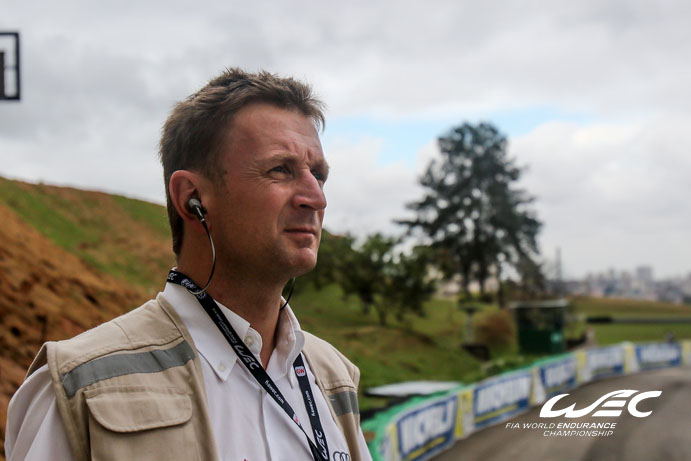

They say a racing driver never loses his edge and, even if they are just watching the action after a successful and decorated career, they are pin-sharp. Allan McNish is living testament to this as he watched the action with us in Free Practice 2 at Interlagos yesterday evening and gave some fascinating opinions.
From the very first moment the three-time 24 Hours of Le Mans 24 Hour winner and 2013 FIA World Endurance Champion set his eyes upon the action, he was making key observations about the cars and circuit in this important ninety-minute session. We are stood just after the awesome Ferradura right hander which sweeps into the tight T7.
“I was here for the F1 race only three weeks ago and I walked the track to see what the new surface was like and you could feel how smooth it was,” said McNish. “The other thing that struck me was how it retained moisture. I even tested it by pouring a bit of water on to it during the trackwalk and it was still there when we came round again even though the air temperature was so high. It will be giving a lot of grip.
“The track temperatures can fluctuate massively here,” continued McNish. “At the GP there was a 14 degree fluctuation throughout the weekend. This has a huge effect on tyre performance obviously. There was blistering with the medium tyre in the F1 on the right front. It will be different here of course but management of the tyres will be a factor; it always is.
“The first thing I have noticed is that the track has rubbered in massively but the circuit will still evolve,” he continues. “Marbles will be less of a problem here. It is always an issue but it will not be like Fuji for instance.”
McNish instantly picks up the fact that the Porsches are riding the kerb well at the tight T7 and that the KCMG ORECA-Nissan appears to be running very stiff and to be adjusting the brake bias a lot into the tighter right hand corner. The next lap he spots the KCMG car without its front bodywork from miles away as it exits T4. The famous 20/20 vision McNish put to such good use in his career is still as sharp as ever!
As the session progresses, McNish sees that the LMP1 cars are taking a variety of momentum through the Ferradura sweep.
“Aero wise the Audis seem to be quicker through the high speed corners,” he says. “This corner (Ferradura) is challenging and is actually two corners in one really. You can see that on entry and exit there is a visible difference in the way the drivers are attacking it. This session is all about tyre data but the Porsche seems not to be able to carry as much momentum in, but on the exit it seems to make up for it and it looks neat and stable. Obviously the lap times indicate this as they are P1 and P2 at the moment.
“Sector two is the sector that hurts the tyres because it is slow corner after slow corner, apart from this one here (Ferradura). You really need mid-corner front grip and very good traction. It can be a double-edged sword for the set-up because, if you have too much understeer, you use your rear tyres more because you have to go onto the power at one point, so it crosses over. The final sector is all about pure traction out of the last left hander and then how much power you have up the hill.”
McNish, who is hooked up to the Audi comms in the pits knows as soon as the drivers do that a light rain shower has begun.
“Marcel (Fassler) has just said it is raining on the main straight,” he states as he looks up to the sky at the same time. “The weather changes really quickly here as we are only a few miles from the sea. But the forecast at this stage is for a dry race so this might compromise the long runs a little.”

The rain eases off and there is no real disruption to the teams' preparations. McNish climbs the grass bank at the top of T7 so that he gets a simultaneous view of the front straight as well.
“A few of the cars are bottoming out on the bumps just before the start straight. The new pit entrance shouldn’t be an issue with any potential penalties because the chicane is not severe and they have opened it out. Generally it seems to be a change for the better here from a safety point of view.”
As the session draws to a close we walk back to the pits. McNish remains alert to what the cars are doing now that the circuit has properly rubbered in and, just like the fans who follow the FIA World Endurance Championship, he is ‘wowed’ by the performance of the most energy-efficient race cars in the world.
“I haven’t been down here at this level and at this corner before,” he says. “It is good to see the cars performing at this point. You know, even from when we unveiled the R10 in 2006 the technical progression of the LMP cars has just been phenomenal. These things are like spaceships now and they are very, very impressive when you see them this close.”
Sam Smith